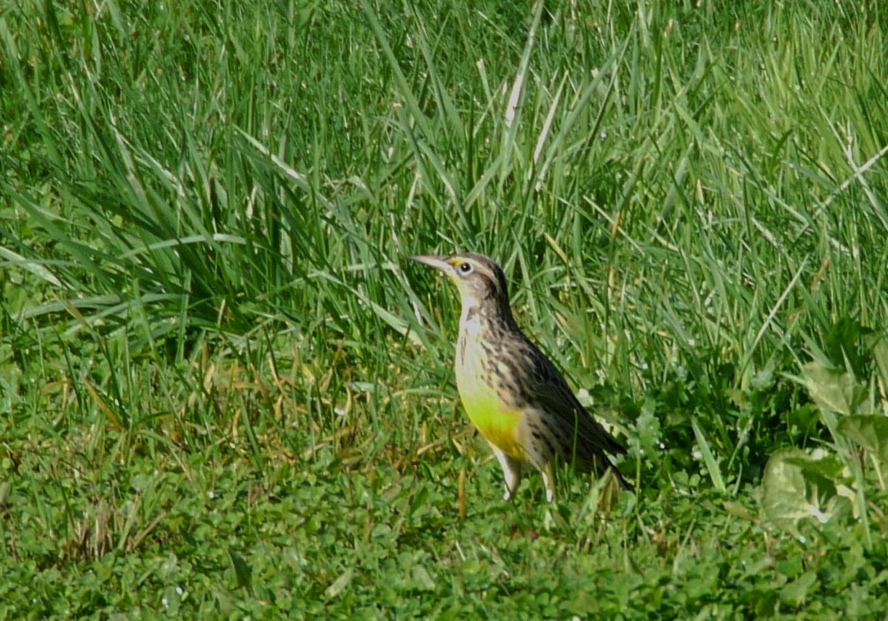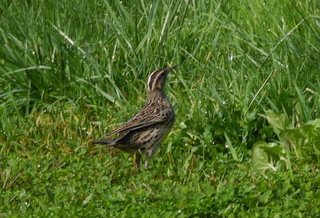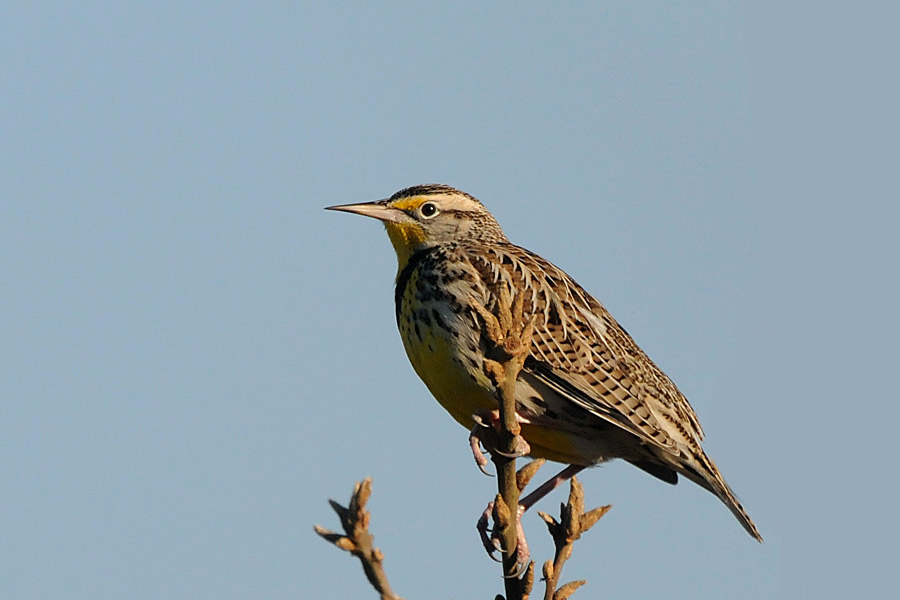Western meadowlark (Sturnella neglecta)
{Sturnella = starling-like; neglecta = chosen by John James Audubon because the Western meadowlark had long been overlooked as a separate species distinct from the Eastern meadowlark}
|
Left: this Western meadowlark was spotted on Calvert Island - an apparently uncommon sighting of this species in the region. Photos by Connie Handley. Right: photo by Mike Yip.
|
Identification
This robin-sized bird has a flat head and a long slender beak. A key identifying feature is the distinct black V contrasting against a bright yellow breast. The yellow colour spreads up into the throat and appears above the eyes and beak. It has contrasting light and dark stripes on its head and black spots along its sides. Its back and wings are patterned in brown, tan, and black. The Western meadowlark's song is composed of a seemingly random but melodious jumble of bubbling and flute-like notes. The notes are usually descending along the scale but accelerating in speed. Listen to the Western meadowlark's song here and here.
Habitat & Range
This bird forages along the ground in meadows, agricultural fields, and other open grassy spaces. It may also be found along roadsides and marsh edges. The Central Coast is at the northern extent of its recorded summer breeding range, which stretches across parts of southern Canada and into the northern United States. However it has been recorded as far north as Alaska. The Western meadowlark is found year-round or in the winter throughout much of the US and parts of Mexico (click here for a Western meadowlark range map). As per its name, it is only rarely found in more eastern provinces and states - those regions are home to the similar Eastern meadowlark (Sturnella magna).
Find more information at the British Columbia Breeding Bird Atlas here.
Intriguing Info
The Western and Eastern meadowlark ranges partially overlap; the two species occasionally hybridize where this overlap occurs. The two species are very similar, and were actually considered a single species until 1844.
This robin-sized bird has a flat head and a long slender beak. A key identifying feature is the distinct black V contrasting against a bright yellow breast. The yellow colour spreads up into the throat and appears above the eyes and beak. It has contrasting light and dark stripes on its head and black spots along its sides. Its back and wings are patterned in brown, tan, and black. The Western meadowlark's song is composed of a seemingly random but melodious jumble of bubbling and flute-like notes. The notes are usually descending along the scale but accelerating in speed. Listen to the Western meadowlark's song here and here.
Habitat & Range
This bird forages along the ground in meadows, agricultural fields, and other open grassy spaces. It may also be found along roadsides and marsh edges. The Central Coast is at the northern extent of its recorded summer breeding range, which stretches across parts of southern Canada and into the northern United States. However it has been recorded as far north as Alaska. The Western meadowlark is found year-round or in the winter throughout much of the US and parts of Mexico (click here for a Western meadowlark range map). As per its name, it is only rarely found in more eastern provinces and states - those regions are home to the similar Eastern meadowlark (Sturnella magna).
Find more information at the British Columbia Breeding Bird Atlas here.
Intriguing Info
The Western and Eastern meadowlark ranges partially overlap; the two species occasionally hybridize where this overlap occurs. The two species are very similar, and were actually considered a single species until 1844.
Identification
Dunn, J. L. and Alderfer, J. (Eds.). (2011). National Geographic Field Guide to the Birds of North America. (6th Ed.). Washington, D.C.: National Geographic Society. Pp. 500-501.
Western Meadowlark. The Birds of North America Online (A. Poole, Ed.). Ithaca: Cornell Lab of Ornithology. Retrieved from the Birds of North America Online. Accessed 28/10/2014.
Western Meadowlark Sturnella neglecta. Audubon Birds. National Audubon Society. Accessed 28/10/2014.
Authors and editors of page
Kelly Fretwell and Brian Starzomski
Dunn, J. L. and Alderfer, J. (Eds.). (2011). National Geographic Field Guide to the Birds of North America. (6th Ed.). Washington, D.C.: National Geographic Society. Pp. 500-501.
Western Meadowlark. The Birds of North America Online (A. Poole, Ed.). Ithaca: Cornell Lab of Ornithology. Retrieved from the Birds of North America Online. Accessed 28/10/2014.
Western Meadowlark Sturnella neglecta. Audubon Birds. National Audubon Society. Accessed 28/10/2014.
Authors and editors of page
Kelly Fretwell and Brian Starzomski






